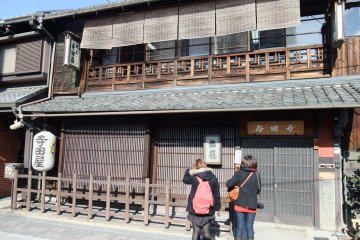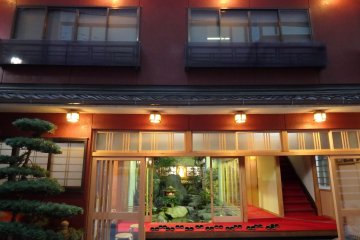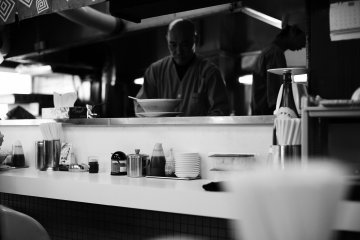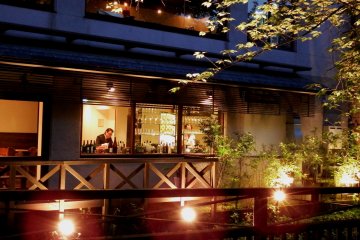
료마를 찾아라 2: 교토 데라다야
Takako Sakamoto사카모토 료마 시리즈 2: 교토 테라다야: 이곳은 사카모토 료마가 당국의 공격을 받은 곳이다. 그의 아내 오료가 다가오는 위험을 그에게 알리기 위해 욕조에서 벌거벗고 뛰어, 그를 구했다!

Founded in 874, Daigo-ji Temple is one of Kyoto's most scenic religious sites. The hillside temple grounds make it a prime spot for cherry blossom and fall foliage, and its traditional buildings add to the rustic charm of the landscape. The main temple grounds are located is at the foot of the mountain and is connected to several other temple buildings around the summit via a hiking trail.
The Daigo-ji also plays an important role in the Shingon sect of Japanese Buddhism. Its main buildings are home to dozens of valuable cultural artifacts, which has resulted in the Daigo-ji Temple being named a World Heritage Site by UNESCO. The main area of the temple is home to the Reihokan Museum, which preserves and exhibits the temple's vast collection of historical documents and art objects, including statues and paintings.
10-minute walk from Daigo Station on the Tozai Subway Line
Keihan Express Bus to “Daigo -ji” bus stop(from JR Kyoto Station, Hachijoguchi Bus Stop) or to “Daigo -ji mae” bus stop (from JR Yamashina Station and Rokujizo Station on the Keihan Railway)

사카모토 료마 시리즈 2: 교토 테라다야: 이곳은 사카모토 료마가 당국의 공격을 받은 곳이다. 그의 아내 오료가 다가오는 위험을 그에게 알리기 위해 욕조에서 벌거벗고 뛰어, 그를 구했다!



다이이치 아사히 라멘 (일본어 링크: http://www.honke-daiichiasahi.com/)은 교토역 근처에 있는 교토 스타일 라멘집이다. 이 식당은 평소보다 진한 쇼유 (소야)를 기반으로 한 국물로 잘 알려져 있다. 맛집이기 때문에 줄을 설 준비를 하셔야 할꺼다. 가격은 꽤 저렴하고, 이 집의 시그니쳐 라멘은 800엔 이다. 타카쿠라도리와 시오코지도리를 교차로 근처 교토역 북쪽으로 걸어오시면 5분 정도밖에 안 걸리고. 영업은 오전 5시부터 오전 2시까지 한다.

트라토리아 미노우라는 고다이지와 야사카 진자사당 근처에 있는 작은 식당이다. 평일 점심 세트(1500엔)는 합리적이고 맛도 좋았다. 그것은 작은 샐러드와 빵을 곁들인 주요 파스타 요리를 포함한다. 술과 후식은 별도이다.

양 요리 'MIKAKU', 기온 시라카와, 교토; 내가 시라카와 강을 따라 걸어가고 있을 때, 따뜻한 빛으로 불이 켜져 있는 멋지고 세련된 강변 식당이 눈에 띄었고, 갑자기 나는 그곳에 가고 싶었다

Ōbaku-san Manpuku-ji is a temple located in Uji, Kyoto. It is the head temple of the Japanese Ōbaku Zen sect, named after Wanfu Temple in Fujian, China. The mountain is likewise named after Mount Huangbo, where the Chinese temple is situated. [Wikipedia]

Fushimi Inari, officially known as Fushimi Inari Taisha, is a beautiful Shinto shrine in southern Kyoto, famous for its thousands of vermilion torii. The torii gates along the way are donations from individuals and companies and on the back of each gate is the name of the donor and the date of the donation. The trails lead into the wooded forest of the sacred mountain Inari, which is 233 meters high and is part of the shrine grounds. The hike to the top of the mountain and the way back take about 2-3 hours. The shrine is dedicated to Inari, the Shinto god of rice. Since it is believed that foxes are Inari's messengers, there are numerous fox statues throughout the shrine grounds. The Fushimi Inari Shrine is the main shrine of all 30,000 Inari shrines in Japan.

Tofukuji temple (東福寺), particularly known for its autumn leaves, was founded in 1236 and is the head temple of the Tofukuji School of the Rinzai sect of Zen Buddhism.